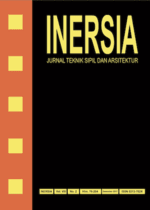EKSPERIMEN PADA STRUKTUR PILE CAP TIGA TIANG DENGAN METODE STRUT AND TIE MODEL
DOI:
https://doi.org/10.21831/inersia.v15i2.28619Keywords:
crack pattern, pile cap, three-piles, strut and tie modelAbstract
ABSTRACTIn general, the design of the pile cap structure still uses conventional method assuming all regions experience linear strain. However, in reality the strain distribution in the cross section of the structure is not always linear so that a rational analysis method is needed with the assumption that is close to the actual condition using the strut and tie model method. This study aims to determine the behavior of crack pattern in the pile cap designed using the strut and tie model method (SNI 2847:2013 Appendix A) compared to conventional methods (SNI 2847:2013 Article 15). The specimen is the pile cap with three-piles and concentrated load, each of which has three methods. Loading is a static load that is channeled through a column located centric towards the structure of the pile cap. The results show that: the entire test object based on the two methods have flexural crack pattern. The average load capacity of the first crack (Pcr) on the specimen was designed using the strut and tie model and the conventional method were 239.0 kN and 193.7 kN. The average of crack width on the specimen using the strut and tie model and the conventional method were 0.68 mm and 3.88 mm.
Keywords: crack pattern, pile cap, three-piles, strut and tie model ABSTRAK
Pada umumnya perancangan struktur pile cap masih menggunakan metode konvensional dengan asumsi semua daerah mengalami regangan linier. Akan tetapi pada kenyataannya distribusi regangan pada penampang struktur tidak selalu linier sehingga diperlukan suatu metode analisis yang rasional dengan asumsi yang mendekati kondisi sebenarnya yaitu menggunakan metode strut and tie model. Penelitian ini bertujuan untuk mengetahui perilaku pola retak pada pile cap yang dirancang dengan metode strut and tie model (SNI 2847:2013 Lampiran A) dibandingkan dengan metode konvensional (SNI 2847:2013 Pasal 15). Pada setiap metode terdiri dari tiga buah benda uji berupa pile cap tiga tiang dengan beban sentris. Pembebanan berupa beban statis yang disalurkan melalui kolom yang terletak sentris terhadap struktur pile cap. Hasil pengujian menunjukkan bahwa keseluruhan benda uji berdasarkan kedua metode mempunyai pola retak lentur (flexural crack). Untuk rata-rata kapasitas beban saat retak pertama (Pcr) pada benda uji yang dirancang menggunakan metode strut and tie model dan metode konvensional adalah sebesar 239,0 kN dan 193,7 kN. Kemudian rata-rata lebar retak pada benda uji menggunakan metode strut and tie model dan metode konvensional adalah sebesar 0,68 mm dan 3,88 mm.
Kata kunci: pola retak, pile cap, tiga tiang, strut and tie modelDownloads
Published
How to Cite
Issue
Section
License
Authors who publish with INERSIA journal agree to the following terms:
- Authors retain copyright and grant the INERSIA journal right of first publication with the work simultaneously licensed under Creative Commons Attribution License (CC BY 4.0) that allows others to share the work with an acknowledgment of the work's authorship and initial publication in this journal.
- Authors can enter into separate, additional contractual arrangements for the non-exclusive distribution of the published version of the work (e.g., post it to an institutional repository or edit it in a book), with an acknowledgment of its initial publication in this journal.
- Authors are permitted and encouraged to post their work online (e.g., in institutional repositories or on their website) before and during the submission process, as it can lead to productive exchanges, as well as earlier and greater citation of published work.

INERSIA by https://journal.uny.ac.id/index.php/inersia was distributed under a Creative Commons Attribution 4.0 International License










